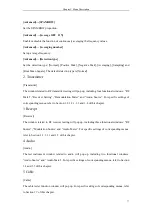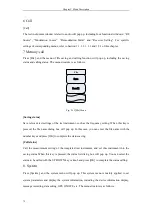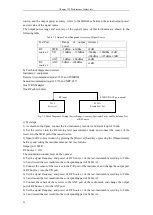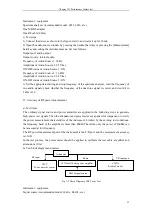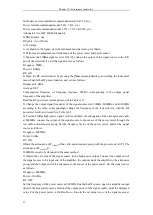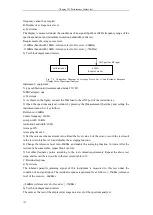
Chapter VII Performance feature test
88
2) Open the RF source window by pressing the [Receiver] hard key or pressing the [Measurement]
hard key and setting the instrument menu. Set it as follows.
Port: SWR
RF Source 1 Power: -5dBm
RF Source 1: ON
Set the output frequency of RF Source 1 as 2MHz and 100MHz, and increase it step by step to
100MHz to 1000MHz.
3) According to the output frequency of RF Source 1, properly adjust the center frequency of the
spectrum analyzer, measure the parasitic harmonics by the standard frequency and standard
frequency difference function, observe and find the point with the poorest harmonics, and record
the test result into Table A.5.
4) Change the output port of RF Source 1 into the ANT port. Test the parasitic harmonics of each
frequency point, observe and find the points with the poorest harmonics, and record the test result
into Table A.5.
5) Close the output of RF Source 1 and perform the following setting.
Port: ANT
RF Source 2 Power: -5dBm
RF Source 2: ON
Set the output frequency of RF Source 2 as 2MHz and 100MHz, and increase it step by step to
100MHz to 400MHz.
6) According to the output frequency of RF Source 2, properly adjust the center frequency of the
spectrum analyzer, measure the parasitic harmonics by the standard frequency and standard
frequency difference function, observe and find the point with the poorest harmonics, and record
the test result into Table A.5.
5. Non-parasitic harmonics of RF source
a) Test items
Non-harmonics refers to the unwanted parasitic or residual signal generated by the frequency
synthesis part. It is a kind of fixed signal output or signal output of certain frequency deviation.
Set the signal generator as a series of output frequency points at which non-harmonics is easily
generated. Tune the spectrum analyzer to the appropriate parasitic signal, and measure and find
the point with the poorest non-harmonics.
Non-harmonics of the signal source of this instrument: ≤-35dBc (frequency deviation: more than
20kHz)
b) Test block diagram and meters
The same output power range and accuracy test.
c) Test steps
1) Connect the device as shown in the figure, start it, and warm it up for 30min.
2) Open the RF source window by pressing the [Receiver] hard key or pressing the [Measurement]
hard key and setting the instrument menu. Set it as follows.
Port: SWR
RF Source 1Power: -5dBm
Frequency of RF Source 1: 2MHz
Summary of Contents for 4992A
Page 1: ...I 4992A Radio Test Set User Manual China Electronics Technology Instruments Co Ltd...
Page 2: ......
Page 5: ......
Page 6: ......
Page 7: ......
Page 23: ...Article I Handling Instructions 11 Article I Handling Instructions...
Page 93: ...81 Article II Technical Specifications...
Page 132: ...Article III Maintenance Instructions 120 Article III Maintenance Instructions...




